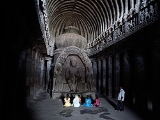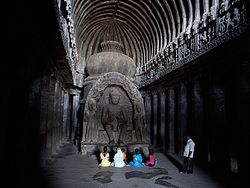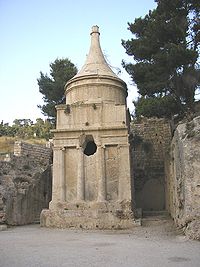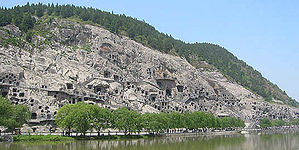
Rock cut architecture
Encyclopedia

Rock (geology)
In geology, rock or stone is a naturally occurring solid aggregate of minerals and/or mineraloids.The Earth's outer solid layer, the lithosphere, is made of rock. In general rocks are of three types, namely, igneous, sedimentary, and metamorphic...
. In India the term 'cave' is often applied, and in China 'cavern,' but one must differentiate natural caves from rock-cut architecture which is man-made and designed along the conventions of architecture itself and thus in every respect a part of architecture and its history. Though rock-cut architecture differs from traditional architecture in many obvious ways, many rock cut structures are often made to replicate traditional architectural forms in the facades and even in their interiors. The interiors were usually carved out by starting at what would wind up being the roof and then working downward, for the obvious reason that stones would not be falling on one's head. The three main uses of rock-cut architecture were temples (like those in India
Indian rock cut architecture
Indian rock-cut architecture is more various and found in greater abundance than any other form of rock-cut architecture around the world. Rock-cut architecture is the practice of creating a structure by carving it out of solid natural rock. Rock that is not part of the structure is removed until...
), tombs (like those in Petra
Petra
Petra is a historical and archaeological city in the Jordanian governorate of Ma'an that is famous for its rock cut architecture and water conduits system. Established sometime around the 6th century BC as the capital city of the Nabataeans, it is a symbol of Jordan as well as its most visited...
, Jordan
Jordan
Jordan , officially the Hashemite Kingdom of Jordan , Al-Mamlaka al-Urduniyya al-Hashemiyya) is a kingdom on the East Bank of the River Jordan. The country borders Saudi Arabia to the east and south-east, Iraq to the north-east, Syria to the north and the West Bank and Israel to the west, sharing...
) and cave dwelling (like those in Cappadocia
Cappadocia
Cappadocia is a historical region in Central Anatolia, largely in Nevşehir Province.In the time of Herodotus, the Cappadocians were reported as occupying the whole region from Mount Taurus to the vicinity of the Euxine...
, Turkey
Turkey
Turkey , known officially as the Republic of Turkey , is a Eurasian country located in Western Asia and in East Thrace in Southeastern Europe...
).
Rock-cut architecture is also said to be cut, hewn, etc., "from the living rock". Another term sometimes associated with rock-cut architecture is monolithic architecture
Monolithic architecture
Monolithic architecture is a style of construction in which a building is carved, cast or excavated from a single piece of material. The most basic form of monolithic architecture is the monolith, such as the monolithic churches of Lalibela, Ethiopia or the Pancha Rathas in India.Buildings with a...
, what is rather applied to free-standing structures made of single piece of material. Monolithic architecture often is rock cut architecture (e.g. Kailasanatha Temple) but monolithic strictures might be also cast of artificial material, e.g. concrete
Concrete
Concrete is a composite construction material, composed of cement and other cementitious materials such as fly ash and slag cement, aggregate , water and chemical admixtures.The word concrete comes from the Latin word...
.
History

Malta
Malta , officially known as the Republic of Malta , is a Southern European country consisting of an archipelago situated in the centre of the Mediterranean, south of Sicily, east of Tunisia and north of Libya, with Gibraltar to the west and Alexandria to the east.Malta covers just over in...
(Hypogeum of Ħal-Saflieni), Sardinia
Sardinia
Sardinia is the second-largest island in the Mediterranean Sea . It is an autonomous region of Italy, and the nearest land masses are the French island of Corsica, the Italian Peninsula, Sicily, Tunisia and the Spanish Balearic Islands.The name Sardinia is from the pre-Roman noun *sard[],...
(Anghelu Ruju, built in 3,000 - 1,500 BCE) and others.
Large scale rock cut structures were built in Ancient Egypt
Ancient Egypt
Ancient Egypt was an ancient civilization of Northeastern Africa, concentrated along the lower reaches of the Nile River in what is now the modern country of Egypt. Egyptian civilization coalesced around 3150 BC with the political unification of Upper and Lower Egypt under the first pharaoh...
and among important monuments could be mentioned the Great Temple of Ramesses II
Ramesses II
Ramesses II , referred to as Ramesses the Great, was the third Egyptian pharaoh of the Nineteenth dynasty. He is often regarded as the greatest, most celebrated, and most powerful pharaoh of the Egyptian Empire...
, known as Abu Simbel
Abu Simbel
Abu Simbel temples refers to two massive rock temples in Abu Simbel in Nubia, southern Egypt on the western bank of Lake Nasser about 230 km southwest of Aswan...
, located along the Nile in Nubia
Nubia
Nubia is a region along the Nile river, which is located in northern Sudan and southern Egypt.There were a number of small Nubian kingdoms throughout the Middle Ages, the last of which collapsed in 1504, when Nubia became divided between Egypt and the Sennar sultanate resulting in the Arabization...
, near the borders of Sudan
Sudan
Sudan , officially the Republic of the Sudan , is a country in North Africa, sometimes considered part of the Middle East politically. It is bordered by Egypt to the north, the Red Sea to the northeast, Eritrea and Ethiopia to the east, South Sudan to the south, the Central African Republic to the...
about 300 kilometers from Aswan
Aswan
Aswan , formerly spelled Assuan, is a city in the south of Egypt, the capital of the Aswan Governorate.It stands on the east bank of the Nile at the first cataract and is a busy market and tourist centre...
in Egypt
Egypt
Egypt , officially the Arab Republic of Egypt, Arabic: , is a country mainly in North Africa, with the Sinai Peninsula forming a land bridge in Southwest Asia. Egypt is thus a transcontinental country, and a major power in Africa, the Mediterranean Basin, the Middle East and the Muslim world...
. It dates from about 1280 BCE, and consists of a monumentally scaled facade carved out of the cliff and a set of interior chambers that form its sanctuary. In the 5th century BCE, the Lycians
Lycians
-Historical accounts:According to Herodotus, the Lycians originally came from Crete and were the followers of Sarpedon. They were expelled by Minos and ultimately settled in territories belonging to the Solymoi of Milyas in Asia Minor. The Lycians were originally known as Termilae before being...
, who inhabited southern Anatolia (now Turkey
Turkey
Turkey , known officially as the Republic of Turkey , is a Eurasian country located in Western Asia and in East Thrace in Southeastern Europe...
) built hundreds of rock-cut tombs
Rock-cut tombs
A rock-cut tomb or Koka is a burial chamber that is cut into the living rock usually along the side of a hill. It was a common form of burial for the wealthy in ancient times in several parts of the world....
on a similar prototype, but smaller in scale. Excellent examples are to be found near Dalyan
Dalyan
Dalyan is a town in Muğla Province located between the well-known districts of Marmaris and Fethiye on the south-west coast of Turkey. The town is an independent municipality, within the administrative district of Ortaca....
, a town in Muğla Province, along the sheer cliffs that faces a river. Since these served as tombs rather than as religious sites, the interiors were usually small and unassuming. The ancient Etruscans of central Italy also left an important legacy of rock-cut architecture, mostly tombs, as those near the city of Tarquinia
Tarquinia
Tarquinia, formerly Corneto and in Antiquity Tarquinii, is an ancient city in the province of Viterbo, Lazio, Italy.- History :Tarquinii is said to have been already a flourishing city when Demaratus of Corinth brought in Greek workmen...
.

The Nabataeans
Nabataeans
Thamudi3.jpgThe Nabataeans, also Nabateans , were ancient peoples of southern Canaan and the northern part of Arabia, whose oasis settlements in the time of Josephus , gave the name of Nabatene to the borderland between Syria and Arabia, from the Euphrates to the Red Sea...
in their city of Petra
Petra
Petra is a historical and archaeological city in the Jordanian governorate of Ma'an that is famous for its rock cut architecture and water conduits system. Established sometime around the 6th century BC as the capital city of the Nabataeans, it is a symbol of Jordan as well as its most visited...
, now in Jordan, extended this tradition, carving their temples and tombs into the yellowish-orange rock that defines the canyons and gullies of the region. These structures, dating from 600 BCE to about 300 CE, are particularly important in the history of architecture given their experimental forms. Here too, because the structrures served as tombs, the interiors were rather perfunctory. In Petra one even finds a theater where the seats are cut out of the rock.
Rock-cut architecture occupies a particularly important place in the history of Indian Architecture.
The earliest instances of Indian rock-cut architecture, the Barabar caves
Barabar Caves
The Barabar Caves are the oldest surviving rock-cut caves in India, mostly dating from the Mauryan period , and some with Ashokan inscriptions, located in the Jehanabad District of Bihar, India, 24 km north of Gaya....
date from about the 3rd to the 2nd century BCE. They were built by the Buddhist monks and consisted mostly of multi-storey buildings carved into the mountain face to contain living and sleeping quarters, kitchens, and monastic spaces. Some of these monastic caves had shrines in them of Buddha, bodhisattvas and saints. As time progressed, the interiors became more elaborate and systemitized; surfaces were often decorated with paintings, such as those at Ajanta
Ajanta
The Ajanta Caves in Aurangabad district of Maharashtra, India are 29 rock-cut cave monuments which date from the 2nd century BCE. The caves include paintings and sculptures considered to be masterpieces of both Buddhist religious art as well as frescos which are reminiscent of the Sigiriya...
. At the beginning of the 7th century Hindu
Hindu
Hindu refers to an identity associated with the philosophical, religious and cultural systems that are indigenous to the Indian subcontinent. As used in the Constitution of India, the word "Hindu" is also attributed to all persons professing any Indian religion...
rock-cut temples began to be constructed at Ellora. Unlike most previous examples of rock-cut architecture which consisted of a facade plus an interior, these temples were complete three-dimensional buildings created by carving away the hillside. They required several generations of planning and coordination to complete. Other major examples of rock-cut architecture in India are at Ajanta
Ajanta
The Ajanta Caves in Aurangabad district of Maharashtra, India are 29 rock-cut cave monuments which date from the 2nd century BCE. The caves include paintings and sculptures considered to be masterpieces of both Buddhist religious art as well as frescos which are reminiscent of the Sigiriya...
and Pataleshwar
Pataleshwar
The Pataleshwar Cave Temple is a rock-cut cave temple, carved out in the 8th century in the Rashtrakuta period. It is located in what is now Pune, in the state of Maharashtra, India...
.

Longmen Grottoes
The Longmen Grottoes or Longmen Caves are one of the finest examples of Chinese Buddhist art. Housing tens of thousands of statues of Buddha and his disciples, they are located south of present day Luòyáng in Hénán province, Peoples Republic of China...
, the Mogao Caves
Mogao Caves
The Mogao Caves or Mogao Grottoes , also known as the Caves of the Thousand Buddhas , form a system of 492 temples southeast of the center of Dunhuang, an oasis strategically located at a religious and cultural crossroads on the Silk Road, in Gansu province, China...
and the Yungang Grottoes
Yungang Grottoes
The Yungang Grottoes are ancient Chinese Buddhist temple grottoes near the city of Datong in the province of Shanxi. They are excellent examples of rock-cut architecture and one of the three most famous ancient Buddhist sculptural sites of China...
consist of hundreds of caves many with statues of Buddha in them. Most were built between 460–525 AD. There are extensive rock-cut buildings, including houses and churches in Cappadocia
Cappadocia
Cappadocia is a historical region in Central Anatolia, largely in Nevşehir Province.In the time of Herodotus, the Cappadocians were reported as occupying the whole region from Mount Taurus to the vicinity of the Euxine...
, Turkey. They were built over a span of hundreds of years prior to the 5th century CE. Emphasis here was more on the interiors than the exteriors.

Lalibela
Lalibela is a town in northern Ethiopia, known for its monolithic churches. Lalibela is one of Ethiopia's holiest cities, second only to Aksum, and is a center of pilgrimage for much of the country. Unlike Aksum, the population of Lalibela is almost completely Ethiopian Orthodox Christian...
, a town in northern Ethiopia, where numerous churches, in three dimensions as at Ellora, were carved out of the rock. These structures, which date from the 12th and 13th centuries CE and which are the last significant examples of this architectural form, ranks as among the most magnificent examples of rock-cut architecture in the world, with both interior and exterior brought to fruition.
Art values
Ancient rock cut tombs, temples and monasteries often have been adorned with frescoes and reliefs. The high resistance of natural cliff, skilled use of plaster and constant microclimate often have helped to preserve this art in better condition than in conventional buildings. Such exceptional examples are the ancient and early medieval frescoes in such locations as Bamyan Caves in Afghanistan with the most ancient known oil paintings in the world from 8th century AD, Ajanta Caves in India with well preserved temperaTempera
Tempera, also known as egg tempera, is a permanent fast-drying painting medium consisting of colored pigment mixed with a water-soluble binder medium . Tempera also refers to the paintings done in this medium. Tempera paintings are very long lasting, and examples from the 1st centuries AD still exist...
paintings from 2nd century BCE, Christian frescoes on Churches of Göreme, Turkey
Churches of Göreme, Turkey
Göreme is a district of the Nevşehir Province in Turkey. After the eruption of Mount Erciyes about 2,000 years ago, ash and lava formed soft rocks in the Cappadocia Region, covering a region of about 20,000 km2. The softer rock was eroded by wind and water, leaving the hard cap rock on top...
and numerous other monuments in Asia, Europe and Africa.
See also
- Monolithic churchMonolithic churchA monolithic church or rock-hewn church is a church made from a single block of stone. They are one of the most basic forms of monolithic architecture....
and monolithic architectureMonolithic architectureMonolithic architecture is a style of construction in which a building is carved, cast or excavated from a single piece of material. The most basic form of monolithic architecture is the monolith, such as the monolithic churches of Lalibela, Ethiopia or the Pancha Rathas in India.Buildings with a... - Dugout (shelter)Dugout (shelter)A dugout or dug-out, also known as a pithouse, pit-house, earth lodge, mud hut, is a shelter for humans or domesticated animals and livestock based on a hole or depression dug into the ground. These structures are one of the most ancient types of human housing known to archeologists...
- YaodongYaodongA yaodong or "cave house" is a particular form of earth shelter dwelling common in the Loess Plateau in China's north. They are generally carved out of a hillside or excavated horizontally from a central "sunken courtyard"....
- Cave monasteryCave monasteryA cave monastery is a monastery built in caves, with possible outside facilities. St. Anthony the Great known as the founder of monasticism lived in a cave.- List of cave monasteries :*Albania**St...
- Ostrog monasteryOstrog monasteryThe Monastery of Ostrog is a monastery of the Serbian Orthodox Church placed against an almost vertical background, high up in the large rock of Ostroška Greda, in Montenegro. It is dedicated to Saint Basil of Ostrog . From the monastery, a superb view of the Bjelopavlići plain can be seen...
- LalibelaLalibelaLalibela is a town in northern Ethiopia, known for its monolithic churches. Lalibela is one of Ethiopia's holiest cities, second only to Aksum, and is a center of pilgrimage for much of the country. Unlike Aksum, the population of Lalibela is almost completely Ethiopian Orthodox Christian...
- PetraPetraPetra is a historical and archaeological city in the Jordanian governorate of Ma'an that is famous for its rock cut architecture and water conduits system. Established sometime around the 6th century BC as the capital city of the Nabataeans, it is a symbol of Jordan as well as its most visited...
- ThamudThamudThe Thamūd were a people of ancient Arabia who were known from the 1st millennium BC to near the time of Muhammad. Although they are thought to have originated in southern Arabia, Arabic tradition has them moving north to settle on the slopes of Mount Athlab near Mada'in Saleh...
- List of archaeological sites sorted by country
- List of colossal sculpture in situ
- List of megalithic sites
- Indian rock cut architectureIndian rock cut architectureIndian rock-cut architecture is more various and found in greater abundance than any other form of rock-cut architecture around the world. Rock-cut architecture is the practice of creating a structure by carving it out of solid natural rock. Rock that is not part of the structure is removed until...
- Rock-cut tombsRock-cut tombsA rock-cut tomb or Koka is a burial chamber that is cut into the living rock usually along the side of a hill. It was a common form of burial for the wealthy in ancient times in several parts of the world....

